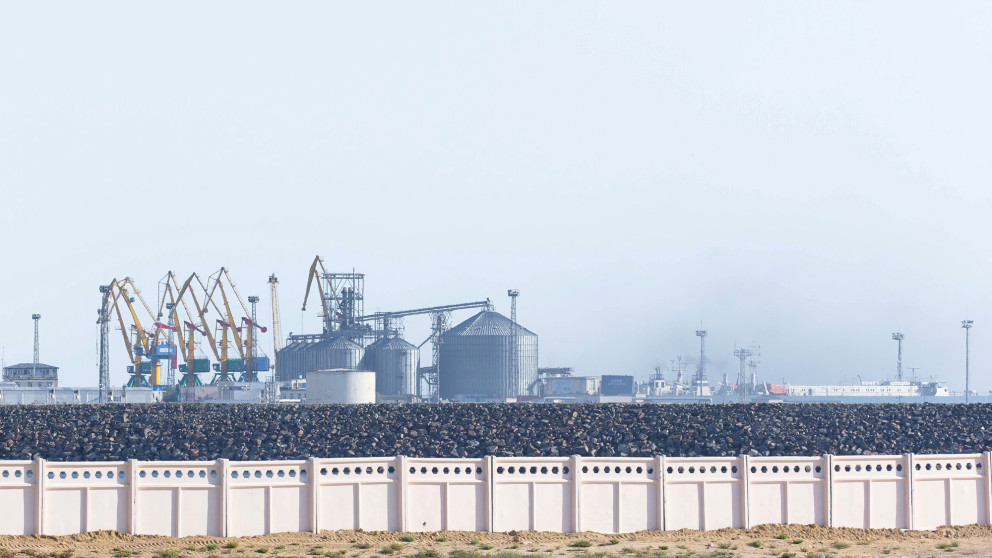Kazakhstan’s Hydrogen Ambitions Should Extend Beyond Exports
24.09.2024

The EU can provide valuable assistance for Kazakhstan when it comes to developing a hydrogen strategy, from regulatory frameworks to sustainability standards, writes RIFS researcher Yana Zabanova in an article first published on 13 September, 2024, by Carnegie Politika.
Recent years have seen a wave of global interest in the European Union’s plans to import up to 10 million tons of green hydrogen (hydrogen produced by the electrolysis of water powered by renewable electricity) by 2030. The EU and member states like Germany have stepped up their engagement on hydrogen with a wide range of partners around the globe, including Kazakhstan. In November 2022, the EU and Kazakhstan signed a strategic partnership on green hydrogen and critical raw materials, and in March 2023, Germany opened a Hydrogen Diplomacy Office in Astana.
Yet Europe’s vision of ramping up the international hydrogen trade is running into obstacles. Cross-border hydrogen infrastructure is expensive; cost decreases for hydrogen have been slow coming; and industrial demand for clean hydrogen has been lower than expected. (Other types of clean, or low-carbon, hydrogen include nuclear hydrogen, where electrolysis is powered by electricity from nuclear sources, and blue hydrogen, produced from natural gas with CO2 emissions captured.) In July 2024, the European Court of Auditors made headlines with a report urging a “reality check” for the EU’s hydrogen policy and its ambitious production and import targets. In the context of these delays, potential producers like Kazakhstan would do well to prioritize the hydrogen-driven decarbonization of their domestic economies.
Kazakhstan made its appearance on the global hydrogen map in June 2021, when the Swedish-German energy company Svevind announced plans to develop a $50 billion green hydrogen project—one of the world’s largest—in the country. Despite some skepticism over feasibility, an official investment agreement with the Kazakh government followed in October 2022.
Known as HyrasiaOne, the project envisions the installation of 40 gigawatts of dedicated wind and solar capacity in the Mangystau region near the Caspian Sea—more than in Kazakhstan’s entire national power system—to produce 2 million tons of green hydrogen or 11 million tons of green ammonia by 2030. HyrasiaOne is currently at the conceptual engineering stage, with the final investment decision due in 2026.
The possibility of exporting hydrogen to Europe clearly played a key role in attracting Svevind to Kazakhstan. Yet many uncertainties remain about the scale and timeline of the EU’s hydrogen demand. The EU is the first global player to introduce binding green hydrogen quotas for industry and transport (to be applied from 2030 onward), but, as some argue, these could be largely met by European suppliers, at least initially. Quotas are likely to increase, but no concrete targets have been set beyond 2035.
Politically, the EU’s vision of large-scale hydrogen imports is not shared by all member states. Germany has been the most active proponent of hydrogen trade with third countries. In its hydrogen import strategy adopted in July 2024—the first strategic document of this kind in the EU—Germany announced plans to import 50–70 percent of its expected hydrogen consumption by 2030, and likely an even greater share by 2045. In contrast, most other member states choose to focus on promoting domestic hydrogen production and consumption. A few, like Spain and Portugal, have major export ambitions of their own, and some, like France, are skeptical about imports more generally, viewing them as fostering a short-sighted dependency.
Green hydrogen can be produced at competitive prices in a number of renewables-rich locations worldwide, but the critical bottleneck is the lack of hydrogen transport infrastructure to bring it to Europe. The EU has a very limited budget to finance hydrogen infrastructure links with third countries. The only such project to receive the priority status that unlocks EU funding is a Norway-Germany hydrogen pipeline due to become operational in 2038. Member states can also use national funding for infrastructure. However, while Germany has announced plans to mobilize funds for infrastructure investment, it is prioritizing states such as Norway, the UK, and Mediterranean countries. Private investors are wary of committing to highly capital-intensive infrastructure projects.
Another issue is the choice of the supply route. Prior to the war in Ukraine, it might have been conceivable to transport Kazakh hydrogen to Europe through Russian territory via retrofitted gas pipelines. But that is no longer a palatable option, and the alternatives are complicated. One possibility would be to construct an offshore hydrogen pipeline crossing the Caspian Sea and continuing to Southern Europe through the Caucasus and Turkey. However, Russia has strongly opposed the construction of any trans-Caspian pipelines in the past and would likely raise objections on environmental grounds this time as well.
More flexible (but also costlier) are multimodal options. For example, it would be possible to convert hydrogen to ammonia and transport it by tanker over the Caspian Sea to Azerbaijan, and from there via a yet-to-be-constructed ammonia pipeline to the Black Sea and on to Romania or Bulgaria. All of these options would require a consortium of investors and close coordination with transit states.
Hydrogen exports, however, are not an end in themselves. There is growing global interest in using clean hydrogen to produce higher-value industrial products, both for domestic use and for export. Chile, Morocco, and South Africa are already shifting their focus from exporting hydrogen to using it to produce green fertilizers, green steel, or e-fuels. Using hydrogen to decarbonize the Kazakh economy was the key message at the Central Asian & European Hydrogen Diplomacy Forum in Astana in May 2024. HyrasiaOne is now increasingly emphasizing that the project is open to supplying the domestic market.
Kazakhstan could use green hydrogen to decarbonize its refineries, steel production, and the chemical industry, although that would require significant levels of new investment. So far, only Kazakhstan’s national oil and gas company KazMunayGas (KMG) has made tentative steps in this direction. In 2022, its subsidiary KMG Engineering launched the Hydrogen Energy Competence Center and the Hydrogen Technologies Research Laboratory in Atyrau. KMG is currently planning pilot clean hydrogen projects as part of its low-carbon development strategy.
In the steel industry, hydrogen can be used to produce direct reduced iron (DRI), and in the chemical industry, to decarbonize ammonia production. Here, neighboring Uzbekistan’s experience might be instructive: its state-owned chemical company UzKimyoSanoat is developing Central Asia’s first green ammonia project in partnership with Saudi Arabia’s ACWA Power, with plans to produce green fertilizers. In the future, Kazakhstan’s renewable energy and hydrogen potential could also help attract energy-intensive industries in what is known as the “renewables pull effect.”
For now, though, Kazakhstan lacks a developed hydrogen policy framework. While the country’s 2060 Net Zero Strategy does mention the use of clean hydrogen for decarbonization, specific targets are missing. The very low CO2 prices in Kazakhstan’s emissions trading system also mean there is little incentive for industrial decarbonization. Nor are there any dedicated policy instruments for stimulating hydrogen demand in key sectors.
Nevertheless, there are some signs of progress. In April 2024, Kazakhstan’s Energy Ministry released the draft 2040 Hydrogen Development Concept. The document puts a strong emphasis on economic diversification and calls for promoting R&D, raising the share of local content in hydrogen technologies, and implementing a pilot blue hydrogen project by 2030. At the same time, hydrogen exports are not presented as the main driver. And while the concept sets some targets (10 gigawatts in electrolyzer capacity and 10 gigawatts in dedicated renewable generation capacity for green hydrogen production by 2040), these figures seem aspirational. The concept also lacks clear priorities, listing a large number of potential hydrogen uses, including less promising ones. Even so, it is an important milestone.
In sum, the slow growth of an international hydrogen market and the lack of cross-border transport infrastructure make hydrogen exports from Kazakhstan to Europe unlikely in the short and medium term. Nevertheless, Kazakhstan should capitalize on its green hydrogen potential. Hydrogen can be used to produce higher-value green industrial products, generating positive spillover effects for the economy. The EU can provide valuable assistance to Kazakhstan in promoting R&D, mobilizing investment, creating a solid regulatory framework, and developing strong sustainability standards.
